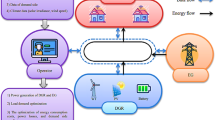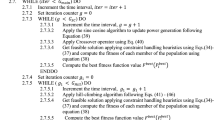Abstract
Proposing a high effective objective function by utilizing optimal weighting factors plays an important role in power systems to boost the quality, attitude, and efficiency of evaluating the position and capacity of renewable distributed generators (RDGs) optimally. This research introduces a comprehensive study of different effective objective functions. A comprehensive analysis between the most modern optimization techniques, like hybrid particle swarm optimization (PSO) with Quazi-Newton, hybrid PSO with gravitational search algorithm, grasshopper optimization algorithm, moth-flame optimization, and slap-swarm algorithm, is done in order to determine the best optimizer with respect to high performance, high accuracy, and the minimum convergence time. The best prepared methodology is proposed and compared with other modern techniques to validate its performance. The suggested scheme is exercised by studying the impact of the RDGs integration for 33 and 69 nodes of IEEE distribution grids, in addition to one of the Egyptian radial distribution networks as a practical case study within 24 h at different load levels. The numerical results confirmed the importance and usefulness of incorporating electing the efficient objective function and superior optimization algorithm in the power system to achieve a successful global optimum solution to ensure the power quality through enhanced voltage levels, while minifying the system power losses and the operating prices.





















Similar content being viewed by others
References
Tulsky VN, Vanin AS, Tolba MA, Diab AAZ (2016) Study and analysis of power quality for an electric power distribution system—case study: Moscow region. In: IEEE NW conference, EIConRusNW, pp 710–716
Tulsky VN, Tolba MA, Diab AAZ, Radwan AA, Foly OM (2017) Measurement and analysis of an electric power distribution system with optimal reactive power compensation for improving the power quality. Case study: Middle Egypt region. In: IEEE conference, EIConRus, pp 1613–1618
Kalambe S, Aggnihotri G (2014) Loss minimization techniques used in distribution network: bibliographical survey. Renew Sustain Energy Rev 29:184–200
Sultana U, Khairuddin AB, Aman MM, Mokhtar AS, Zareen N (2016) A review of optimum DG placement based on minimization of power losses and voltage stability enhancement of distribution system. Renew Sustain Energy Rev 63:363–378
Tolba MA, Tulsky VN, Diab AAZ, Abdelaziz AY (2018) VLCI approach for optimal capacitors allocation in distribution networks based on hybrid PSOGSA optimization algorithm. Neural Comput Appl. https://doi.org/10.1007/s00521-017-3327-7
Tolba MA, Tulsky VN, Diab AAZ (2017) Optimal sitting and sizing of renewable distributed generations in distribution networks using a hybrid PSOGSA optimization algorithm. In: IEEE 1st and 17th conference of I&CPS/IEEE-EEEIC’17, Milan, Italy
Nguyen TT, Truong AV, Phung TA (2016) A novel method based on adaptive cuckoo search for optimal network reconfiguration and distributed generation allocation in distribution network. Electr Power Energy Syst 78:801–815. https://doi.org/10.1016/j.ijepes.2015.12.030
Mitra J, Vallem MR, Singh C (2016) Optimal deployment of distributed generation using a reliability criterion. IEEE Trans Ind Appl 52(3):1989–1997
Adefarati T, Bansal RC (2016) Integration of renewable distributed generators into the distribution system: a review. IET Renew Power Gener 10(7):873–884
Nguyen TP, Tran TT, Ngoc Vo D (2018) Improved stochastic fractal search algorithm with chaos for optimal determination of location, size, and quantity of distributed generators in distribution systems. Neural Comput Appl. https://doi.org/10.1007/s00521-018-3603-1
El-Fergany A (2015) Optimal allocation of multi-type distributed generators using backtracking search optimization algorithm. Electr Power Energy Syst 64:1197–1205
Painuly JP, Fenhann JV (2002) Implementation of renewable energy technologies, opportunities and barriers. UNEP collaborating center on Energy and Environment Riso National Laboratory, ch. 4, sec. 4.1.1–4.1.7, Denmark, ISBN: 87-550- 3013-0, pp 9–17
(2015) Egypt energy policy, laws and regulations handbook: strategic information, policy, regulations, vol 1. International Business Publications, USA, p 278
Arabic Republic of Egypt, Ministry of electricity and renewable energy, Egyptian Electricity Holding Company (2015) “General annual report english version 2014–2015”. Available: http://www.moee.gov.eg. Accessed 2018
Arabic Republic of Egypt, Ministry of electricity and renewable energy (2018) “Renewable global status report”. Available: http://www.nrea.gov.eg/. Accessed 2018
Egypt Country Commercial Guide, export.gov (2017) “Egypt renewable energy”. Available: https://www.export.gov/article?id=Egypt-Renewable-Energy. Accessed 2018
Lalitha MP, Reddy NS, Reddy VCV (2010) Optimal DG placement for maximum loss reduction in radial distribution system using ABC algorithm. Int J Rev Comput 3:44–52
Abu-Mouti FS, El-Hawary ME (2011) Optimal distributed generation allocation and sizing in distribution systems via artificial bee colony algorithm. IEEE Trans Power Deliv 26(4):2090–2101
Tan WS, Hassan MY, Majid MS, Rahman HA (2012) Allocation and sizing of DG using cuckoo search algorithm. In: IEEE international conference on power and energy (PECon), Kota Kinabalu, Malaysia. https://doi.org/10.1109/pecon.2012.6450192
Moradi MN, Abedini M (2011) A combination of genetic algorithm and particle swarm optimization for optimal DG location and sizing in distribution systems. Int J Electr Power Energy Syst 34:66–74. https://doi.org/10.1109/IPECON.2010.5697086
Hung DQ, Mithulananthan N (2013) Multiple distributed generators placement in primary distribution networks for loss reduction. IEEE Trans Ind Electron J 60(4):1700–1708
Manafi H, Ghadimi N, Ojaroudi M, Farhadi P (2013) Optimal placement of distributed generations in radial distribution systems using various PSO and DE algorithms. Elektron Elektrotech J 19(10):53–57
Injeti SK, Kumar NP (2013) A novel approach to identify optimal access point and capacity of multiple DGs in a small, medium and large scale radial distribution systems. Int J Electr Power Energy Syst 45:142–151. https://doi.org/10.1016/j.ijepes.2012.08.043
Imran MA, Kowsalya M (2014) Optimal size and siting of multiple distribution generators in distribution system using bacterial foraging optimization. Swarm Evolut Comput 15:58–65
Abdelaziz A, Hegazy Y, El-Khattam W, Othman M (2015) A multi-objective optimization for sizing and placement of voltage-controlled distributed generation using supervised big bang–big crunch method. Electr Power Compon Syst 43(1):105–117
Yammani C, Maheswarapu S, Matam SK (2016) A multi-objective shuffled bat algorithm for optimal placement and sizing of multi distributed generations with different load models. Electr Power Energy Syst 79:120–131
Sobieh A, Mandour M, Saied EM, Salama MM (2017) Optimal number size and location of distributed generation units in radial distribution systems using Grey Wolf optimizer. Int Electr Eng J (IEEJ) 7(9):2367–2376
ChithraDevi SA, Lakshminarasimman L, Balamurugan R (2017) Stud Krill herd algorithm for multiple DG placement and sizing in a radial distribution system. Eng Sci Technol Int J (JESTECH) 20(2):748–759
Sanjay R, Jayabarathi T, Raghunathan T, Ramesh V, Mithulananthan N (2017) Optimal allocation of distributed generation using hybrid Grey Wolf optimizer. IEEE Access 5:14807–14818. https://doi.org/10.1109/ACCESS.2017.2726586
Kansal S, Kumar V, Tyagi B (2016) Hybrid approach for optimal placement of multiple DGs of multiple types in distribution networks. Int J Electr Power Energy Syst 75:226–235
Mahmoud K, Yorino N, Ahmed A (2016) Optimal distributed generation allocation in distribution systems for loss minimization. IEEE Trans Power Syst 31(2):960–969
Jamian JJ, Mustafa MW, Mokhlis H (2015) Optimal multiple distributed generation output through rank evolutionary particle swarm optimization. Neurocomputing 152:190–198
Kollu R, Rayapudi SR, Sadhu VLN (2012) A novel method for optimal placement of distributed generation in distribution systems using HSDO. Eur Trans Electr Power 24:547–561. https://doi.org/10.1002/etep.1710
Ganguly S, Samajpati D (2017) Distributed generation allocation with on-load tap changer on radial distribution networks using adaptive genetic algorithm. Appl Soft Comput 59:45–67
Muthukumar K, Jayalalitha S (2016) Optimal placement and sizing of distributed generators and shunt capacitors for power loss minimization in radial distribution networks using hybrid heuristic search optimization technique. Int J Electr Power Energy Syst 78:299–319
Tah A, Das D (2016) Novel analytical method for the placement and sizing of distributed generation unit on distribution networks with and without considering P and PQV buses. Int J Electr Power Energy Syst 78:401–413
Kaur S, Kumbhar G, Sharma J (2014) A MINLP technique for optimal placement of multiple DG units in distribution systems. Int J Electr Power Energy Syst 63:609–617
García JAM, Mena AJG (2013) Optimal distributed generation location and size using a modified teaching–learning based optimization algorithm. Int J Electr Power Energy Syst 50:65–75
Kefayat M, Ara AL, Niaki SAN (2015) A hybrid of ant colony optimization and artificial bee colony algorithm for probabilistic optimal placement and sizing of distributed energy resources. Energy Convers Manag 92:149–161
Tolba MA, Tulsky VN, Diab AAZ (2017) Optimal allocation and sizing of multiple distributed generators in distribution networks using a novel hybrid particle swarm optimization algorithm. In: IEEE conference, EIConRus, pp 1606–1612
IEEE Standard 1159-2009 (2009) IEEE recommended practice for monitoring electric power quality
IEEE Standard 1346-1998 (1998) IEEE recommended practice for evaluation electric power system compatibility with electronic process equipment
IEC Standard 61000-4-30 (2015) Electromagnetic compatibility (EMC)—part 4–30: testing and measurement techniques—power quality measurement methods
Sajjadi SM, Haghifam MR, Salehi J (2013) Simultaneous placement of distributed generation and capacitors in distribution networks considering voltage stability index. Electr Power Energy Syst 46:366–375
Dixit M, Kundu P, Jariwala HR (2017) Incorporation of distributed generation and shunt capacitor in radial distribution system for techno-economic benefits. Eng Sci Technol Int J 20:482–493. https://doi.org/10.1016/j.jestch.2017.01.003
Mirjalili S, Hashim Sitti ZM (2010) A new hybrid PSOGSA algorithm for function optimization. In: International conference on computer and information application, (ICCIA 2010). IEEE
Kennedy J, Eberhart RC (1995) Particle swarm optimization. In: Proceedings of the IEEE international conference on neural networks IV. IEEE Service Center, Piscataway, NJ, pp 1942–1948
Rashedi E, Nezamabadi S, Saryazdi S (2009) GSA: a gravitational search algorithm. Inf Sci 179(3):2232–2248
Mirjalili S (2015) Moth-flame optimization algorithm: a novel nature-inspired heuristics paradigm. Knowl Based Syst. https://doi.org/10.1016/j.knosys.2015.07.006
Saremi S, Mirjalili S, Lewis A (2017) Grasshopper optimization algorithm: theory and application. Adv Eng Softw J 105:30–47
Simpson SJ, McCaffery AR, HAGELE BF (1999) A behavioural analysis of phase change in the desert locust. Biol Rev 74:461–480. https://doi.org/10.1111/j.1469-185X.1999.tb00038.x
Rogers SM, Matheson T, Despland E, Dodgson T, Burrows M, Simpson SJ (2003) Mechanosensory-induced behavioural gregarization in the desert locust Schistocerca gregaria. J Exp Biol 206:3991–4002. https://doi.org/10.1242/jeb.00648, https://europepmc.org/article/med/14555739
Coello CA (2002) Theoretical and numerical constraint-handling techniques used with evolutionary algorithms: a survey of the state of the art. Comput Methods Appl Mech Eng 191:1245–1287. https://doi.org/10.1016/S0045-7825(01)00323-1
Spall JC (2005) Introduction to stochastic search and optimization: estimation, simulation, and control, vol 65. Wiley, New York
Mirjalili S, Gandomi A, Mirjalili SZ, Saremi S, Faris H, Mirjalili SM (2017) Salp swarm algorithm: a bio-inspired optimizer for engineering design problems. Adv Eng Softw J 000:1–29
Madin LP (1990) Aspects of jet propulsion in salps. Can J Zool 68:765–777. https://doi.org/10.1139/z90-111
Anderson PAV, Bone Q (1980) Communication between individuals in salp chains II. Physiology. Proc R Soc Lond B 210:559–574. https://doi.org/10.1098/rspb.1980.0153, https://www.jstor.org/stable/35395
Savier JS, Das D (2007) Impact of network reconfiguration on loss allocation of radial distribution systems. IEEE Trans Power Deliv 22(4):2473–2480
Shiroudi A, Taklimi S, Mousavifar S, Taghipour P (2013) Stand-alone PV-hydrogen energy system in Taleghan-Iran using HOMER software: optimization and technoeconomic analysis. Environ Dev Sustain J 15:1389–1402
Benyahia N, Denoun H, Badji A, Zaouia M, Rekioua T, Benamrouche N, Rekioua D (2014) MPPT controller for an interleaved boost dc–dc converter used in fuel cell electric vehicles. Int J Hydrog Energy 39(27):15196–15205
Maher AR, Al-Baghdadi S (2005) Modelling of proton exchange membrane fuel cell performance based on semi-empirical equations. Renew Energy J 30:1587–1599
Hadidian-Moghaddam MJ, Arabi-Nowdeh S, Bigdeli M, Azizian D (2018) A multi-objective optimal sizing and siting of distributed generation using ant lion optimization technique. Ain Shams Eng J 9:2101–2109. https://doi.org/10.1016/j.asej.2017.03.001
Acknowledgements
The authors would like to thank Associate Prof. Dr. Vladimir N. Tulsky (Moscow Power Engineering Institute, Russian Federation) for his support, supervision, and instructions in the whole research. Also, authors thank Assist. Prof. Dr. Ahmed A. Zaki Diab (Faculty of Engineering, Minia University, Egypt) and Dr. Artem Vanin (Moscow Power Engineering Institute, Russian Federation) for their assistance in this research.
Author information
Authors and Affiliations
Corresponding authors
Ethics declarations
Conflict of interest
There is no conflict of interests.
Additional information
Publisher's Note
Springer Nature remains neutral with regard to jurisdictional claims in published maps and institutional affiliations.
Appendix
Rights and permissions
About this article
Cite this article
Tolba, M.A., Rezk, H., Al-Dhaifallah, M. et al. Heuristic optimization techniques for connecting renewable distributed generators on distribution grids. Neural Comput & Applic 32, 14195–14225 (2020). https://doi.org/10.1007/s00521-020-04812-y
Received:
Accepted:
Published:
Issue Date:
DOI: https://doi.org/10.1007/s00521-020-04812-y




